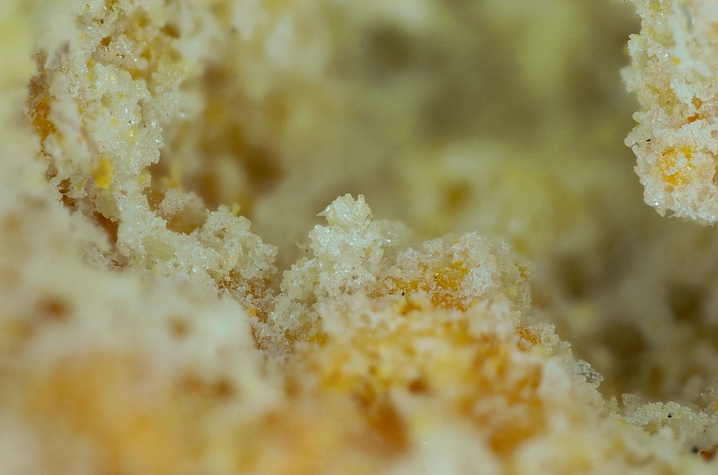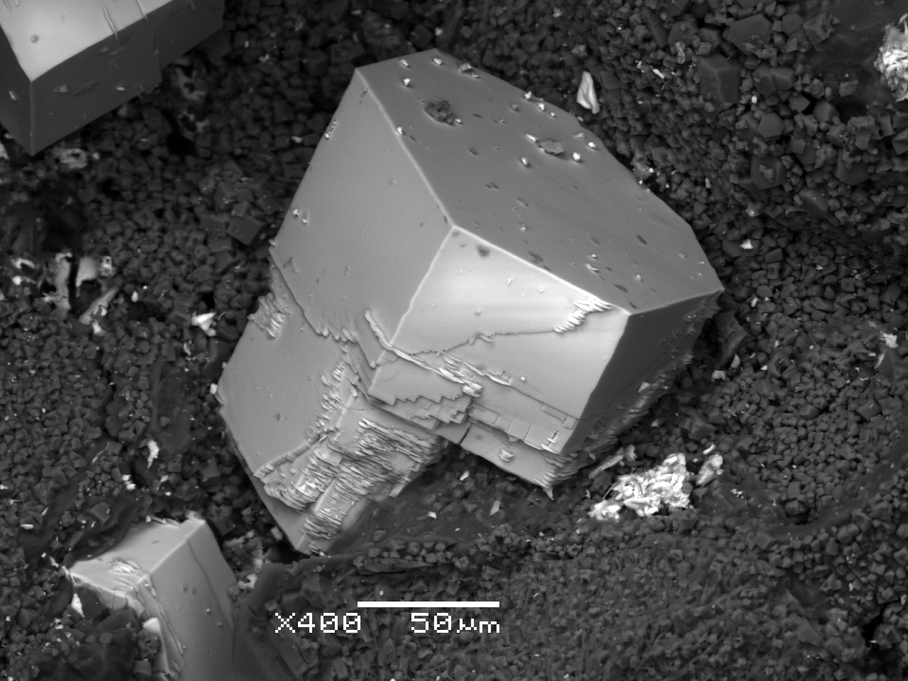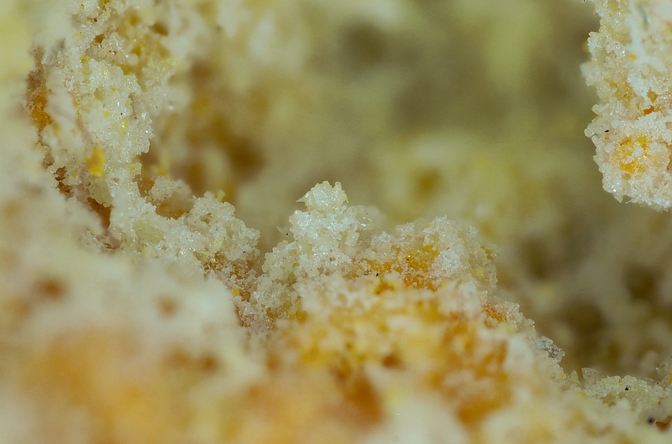Lucabindiite
A valid IMA mineral species
This page is currently not sponsored. Click here to sponsor this page.
About Lucabindiite
Formula:
(K,NH4)As4O6(Cl,Br)
Colour:
colorless to white
Lustre:
Vitreous
Specific Gravity:
3.68 (Calculated)
Crystal System:
Hexagonal
Member of:
Name:
The name is in honor of Luca Bindi (b. 1971), Professor of Mineralogy and former Head of the Division of Mineralogy of the Natural History Museum of the University of Florence
Type Locality:
Isostructural with:
Comparable to torrecillasite and russoite (both As2O3-containing). The Cl analogue of mauriziodiniite.
Unique Identifiers
Mindat ID:
41602
Long-form identifier:
mindat:1:1:41602:1
GUID
(UUID V4):
(UUID V4):
1a616c7d-b0f2-43c3-89fd-625d27e38ac1
IMA Classification of Lucabindiite
Approved
Approval year:
2011
First published:
2013
Classification of Lucabindiite
3.DC.
3 : HALIDES
D : Oxyhalides, hydroxyhalides and related double halides
C : With Pb (As,Sb,Bi), without Cu
3 : HALIDES
D : Oxyhalides, hydroxyhalides and related double halides
C : With Pb (As,Sb,Bi), without Cu
Mineral Symbols
As of 2021 there are now IMA–CNMNC approved mineral symbols (abbreviations) for each mineral species, useful for tables and diagrams.
| Symbol | Source | Reference |
|---|---|---|
| Lbd | IMA–CNMNC | Warr, L.N. (2021). IMA–CNMNC approved mineral symbols. Mineralogical Magazine, 85(3), 291-320. doi:10.1180/mgm.2021.43 |
Pronunciation of Lucabindiite
Pronunciation:
| Play | Recorded by | Country |
|---|---|---|
| Jolyon Ralph | United Kingdom |
Physical Properties of Lucabindiite
Vitreous
Transparency:
Transparent
Colour:
colorless to white
Streak:
white
Fracture:
None observed
Density:
3.68 g/cm3 (Calculated)
Chemistry of Lucabindiite
Mindat Formula:
(K,NH4)As4O6(Cl,Br)
Crystallography of Lucabindiite
Crystal System:
Hexagonal
Class (H-M):
6/mmm (6/m 2/m 2/m) - Dihexagonal Dipyramidal
Space Group:
P6/mmm
Setting:
P6/mmm
Cell Parameters:
a = 5.2386(7) Å, c = 9.014(2) Å
Ratio:
a:c = 1 : 1.721
Unit Cell V:
214.23 ų
Z:
1
Morphology:
Hexagonal and platy crystals
Crystal Structure
Load
Unit Cell | Unit Cell Packed
2x2x2 | 3x3x3 | 4x4x4
Unit Cell | Unit Cell Packed
2x2x2 | 3x3x3 | 4x4x4
Show
Big Balls | Small Balls | Just Balls | Spacefill
Polyhedra Off | Si Polyhedra | All Polyhedra
Remove metal-metal sticks
Big Balls | Small Balls | Just Balls | Spacefill
Polyhedra Off | Si Polyhedra | All Polyhedra
Remove metal-metal sticks
Display Options
Black Background | White Background
Perspective On | Perspective Off
2D | Stereo | Red-Blue | Red-Cyan
Black Background | White Background
Perspective On | Perspective Off
2D | Stereo | Red-Blue | Red-Cyan
View
CIF File Best | x | y | z | a | b | c
CIF File Best | x | y | z | a | b | c
Rotation
Stop | Start
Stop | Start
Labels
Console Off | On | Grey | Yellow
Console Off | On | Grey | Yellow
Data courtesy of the American Mineralogist Crystal Structure Database. Click on an AMCSD ID to view structure
| ID | Species | Reference | Link | Year | Locality | Pressure (GPa) | Temp (K) |
|---|---|---|---|---|---|---|---|
| 0019797 | Lucabindiite | Garavelli A, Mitolo D, Pinto D, Vurro F (2013) Lucabindiite, (K,NH4)As4O6(Cl,Br), a new fumarole mineral from the "La Fossa" crater at Vulcano, Aeolian Islands, Italy American Mineralogist 98 470-477 | 2013 | La Fossa crater at Vulcano, Aeolian Islands, Italy | 0 | 293 | |
| 0019949 | Lucabindiite | Pertlik F (1988) The compounds KAs4O6X (X=Cl,Br,I) and NH4As4O6X (X=Br,I): Hydrothermal syntheses and structure determinations Monatshefte fur Chemie 119 451-456 | 1988 | synthetic | 0 | 293 |
CIF Raw Data - click here to close
X-Ray Powder Diffraction
Powder Diffraction Data:
| d-spacing | Intensity |
|---|---|
| 4.537 Å | (30) |
| 4.507 Å | (52) |
| 3.197 Å | (100) |
| 2.619 Å | (67) |
| 2.265 Å | (19) |
| 1.974 Å | (28) |
| 1.603 Å | (20) |
| 1.485 Å | (21) |
Geological Environment
Paragenetic Mode(s):
| Paragenetic Mode | Earliest Age (Ga) |
|---|---|
| Stage 7: Great Oxidation Event | <2.4 |
| 45a : [Sulfates, arsenates, selenates, antimonates] | |
| 45b : [Other oxidized fumarolic minerals] |
Type Occurrence of Lucabindiite
General Appearance of Type Material:
As aggregates of micrometer-sized hexagonal and platy crystals on the surface of the pyroclastic breccia
Place of Conservation of Type Material:
Museum "C.L. Garavelli", Depart. Geomineralogico, University of Bari "Aldo Moro", Italy, sample no. 11/nm/V28
Geological Setting of Type Material:
fumerole
Associated Minerals at Type Locality:
Reference:
Garavelli, A., Mitolo, D., Pinto, D., Vurro, F. (2013) Lucabindiite, (K,NH4)As4O6(Cl,Br), a new fumarole mineral from the "La Fossa" crater at Vulcano, Aeolian Islands, Italy. American Mineralogist: 98: 470–477.
Synonyms of Lucabindiite
Relationship of Lucabindiite to other Species
Member of:
Other Members of this group:
| Cuatrocapaite-(K) | K3(NaMg◻)(As2O3)6Cl6 · 16H2O | Trig. 3m (3 2/m) : R3m |
| Cuatrocapaite-(NH₄) | (NH4)3(NaMg◻)(As2O3)6Cl6 · 16H2O | Trig. 3m (3 2/m) : R3m |
| Ermakovite | (NH4)(As2O3)2Br | Hex. 6/mmm (6/m 2/m 2/m) : P6/mmm |
| Gajardoite | KCa0.5As3+4O6Cl2 · 5H2O | Hex. 6/mmm (6/m 2/m 2/m) : P6/mmm |
| Gajardoite-(NH4) | (NH4)As3+4O6Cl2(Ca0.5◻0.5)(H2O)5 | Hex. 6/mmm (6/m 2/m 2/m) : P6/mmm |
| Mauriziodiniite | (NH4)(As2O3)2I | Hex. 6/mmm (6/m 2/m 2/m) : P6/mmm |
| Russoite | (NH4)ClAs2O3(H2O)0.5 | Hex. 6 2 2 : P6 2 2 |
| Torrecillasite | Na(As,Sb)3+4O6Cl | Orth. |
Common Associates
Associated Minerals Based on Photo Data:
Related Minerals - Strunz-mindat Grouping
| 3.DC. | Torrecillasite | Na(As,Sb)3+4O6Cl |
| 3.DC. | Gajardoite | KCa0.5As3+4O6Cl2 · 5H2O |
| 3.DC. | Cuatrocapaite-(NH₄) | (NH4)3(NaMg◻)(As2O3)6Cl6 · 16H2O |
| 3.DC. | Cuatrocapaite-(K) | K3(NaMg◻)(As2O3)6Cl6 · 16H2O |
| 3.DC. | Napoliite | Pb2OFCl |
| 3.DC.05 | Laurionite | PbCl(OH) |
| 3.DC.05 | Paralaurionite | PbCl(OH) |
| 3.DC.05 | Russoite | (NH4)ClAs2O3(H2O)0.5 |
| 3.DC.05 | Mauriziodiniite | (NH4)(As2O3)2I |
| 3.DC.10 | Fiedlerite | Pb3FCl4(OH) · H2O |
| 3.DC.15 | Penfieldite | Pb2Cl3(OH) |
| 3.DC.15 | Telluroperite | Pb3TeO4Cl2 |
| 3.DC.20 | Laurelite | Pb7F12Cl2 |
| 3.DC.25 | Bismoclite | BiOCl |
| 3.DC.25 | Matlockite | PbFCl |
| 3.DC.25 | Rorisite | CaFCl |
| 3.DC.25 | Zavaritskite | (BiO)F |
| 3.DC.25 | Zhangpeishanite | BaFCl |
| 3.DC.30 | Nadorite | PbSbClO2 |
| 3.DC.30 | Perite | PbBiClO2 |
| 3.DC.40 | Thorikosite | Pb3Cl2(OH)(SbO3,AsO3) |
| 3.DC.45 | Mereheadite | Pb47Cl25(OH)13O24(CO3)(BO3)2 |
| 3.DC.50 | Blixite | Pb8O5(OH)2Cl4 |
| 3.DC.52 | Rumseyite | Pb2OClF |
| 3.DC.55 | Pinalite | Pb3WO5Cl2 |
| 3.DC.55 | Vladkrivovichevite | [Pb32O18][Pb4Mn2O]Cl14(BO3)8 · 2H2O |
| 3.DC.57 | Yeomanite | Pb2O(OH)Cl |
| 3.DC.60 | Lorettoite | Pb7O6Cl2 |
| 3.DC.60 | Symesite | Pb10(SO4)O7Cl4 · H2O |
| 3.DC.62 | Sarawakite (of Frenzel) | Sb, O, Cl (?) |
| 3.DC.65 | Ecdemite | Pb6Cl4(As2O7) |
| 3.DC.70 | Mendipite | Pb3Cl2O2 |
| 3.DC.75 | Damaraite | Pb3Cl(OH)O2 |
| 3.DC.80 | Onoratoite | Sb8Cl2O11 |
| 3.DC.95 | Barstowite | Pb4Cl6(CO3) · H2O |
Fluorescence of Lucabindiite
non-fluorescent
Other Information
Health Risks:
No information on health risks for this material has been entered into the database. You should always treat mineral specimens with care.
Internet Links for Lucabindiite
mindat.org URL:
https://www.mindat.org/min-41602.html
Please feel free to link to this page.
Please feel free to link to this page.
Search Engines:
External Links:
Mineral Dealers:
References for Lucabindiite
Reference List:
Williams, P. A., Hatert, F., Pasero, M., Mills, S. J. (2011) New minerals and nomenclature modifications approved in 2011, CNMNC Newsletter No. 10. Mineralogical Magazine, 75 (5) 2549-2561 doi:10.1180/minmag.2011.075.5.2549
Localities for Lucabindiite
Locality List
 - This locality has map coordinates listed.
- This locality has map coordinates listed.
 - This locality has estimated coordinates.
ⓘ - Click for references and further information on this occurrence.
? - Indicates mineral may be doubtful at this locality.
- This locality has estimated coordinates.
ⓘ - Click for references and further information on this occurrence.
? - Indicates mineral may be doubtful at this locality.
 - Good crystals or important locality for species.
- Good crystals or important locality for species.
 - World class for species or very significant.
(TL) - Type Locality for a valid mineral species.
(FRL) - First Recorded Locality for everything else (eg varieties).
- World class for species or very significant.
(TL) - Type Locality for a valid mineral species.
(FRL) - First Recorded Locality for everything else (eg varieties).
All localities listed without proper references should be considered as questionable.
Chile | |
| Maurizio Dini |
Italy | |
| Russo et al. (2017) |
| Williams et al. (2011) +1 other reference |
Russia | |
| Shevko et al. (2018) |
Quick NavTopAbout LucabindiiteUnique IdentifiersIMA Classification Classification Mineral SymbolsPronunciation Physical Properties Chemistry Crystallography Crystal StructureX-Ray Powder DiffractionGeological EnvironmentType Occurrence SynonymsRelationshipsCommon AssociatesStrunz-MindatFluorescence Other InformationInternet Links References Localities Locality List








 symbol to view information about a locality.
The
symbol to view information about a locality.
The 



"Bocca Grande" fumarole, Solfatara di Pozzuoli, Pozzuoli, Naples, Campania, Italy